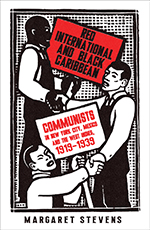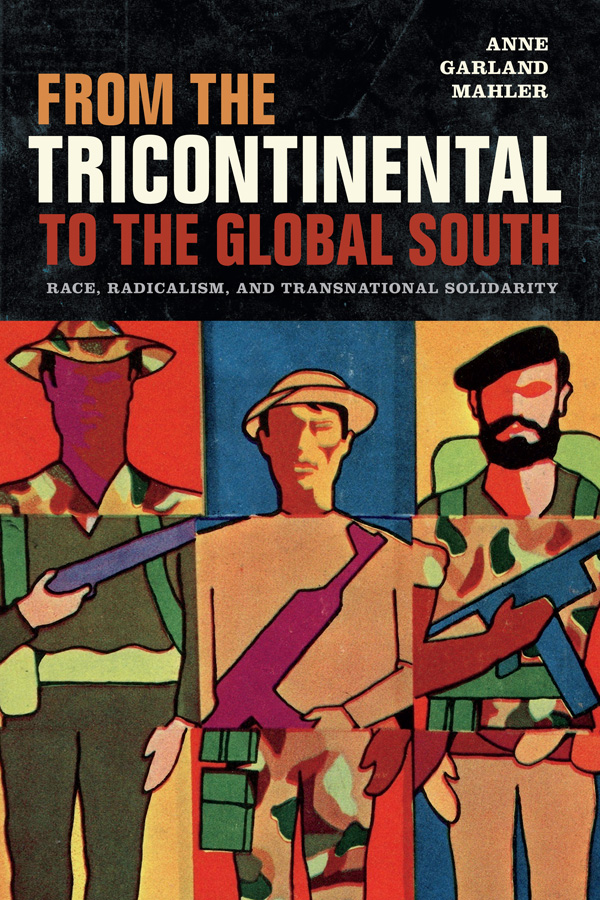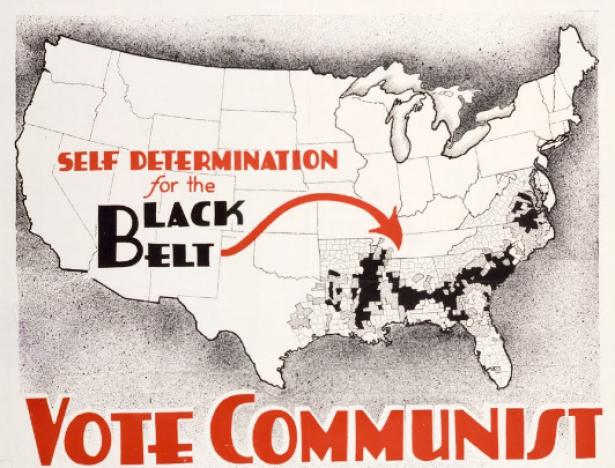When we speak about a future in which all black people in America can be free, it’s hard to picture how, exactly, that freedom might look. Many black communists in the 1930s visualized black autonomy within the United States as a place, with clear delineations between the lands of the free and of the unfree. In response to the demands of black workers’ associations and black nationalist alliances, the Communist International (Comintern) introduced, in 1928, a vision of black political power and black liberation called the “Black Belt”: a sovereign black nation within the southern United States. In its 1930 resolution, the Comintern explicitly endorsed this answer to the “Negro Question,” acknowledging the super-exploitation of black workers under Jim Crow and supporting the political self-determination—even the secession—of majority-black areas of the United States.
When communists of 1928 imagined a “Black Belt,” what, or who, or where did they have in mind? While the Black Belt was an ideological commitment to black self-determination, rather than a concrete plan of action, black communists of that era nevertheless created maps of the territory this nation would occupy in the US South. In one such map, a jagged crescent of dark ink scythes through the southern half of the United States, demarcating a territory that stretches from Maryland to Texas. As the news reminds us daily of the lack of spaces that are free of violence for all people—and particularly people of color—I was struck by the power of these images indicating where black liberation could reside, even as they remained rough renderings of an incomplete, improbable plan.
Where we gather to plan for freedom, and among whom we gather, can determine the shape and scale of our visions for the future. In today’s political discourse, “identity politics” are often dismissed as exclusionary, limited, and divisive grounds for political organizing. New books by Margaret Stevens and Anne Garland Mahler that look to the histories of the Communist International and the Tricontinental movement, respectively, provide an expansive vision of the work that organizing around color and region can do—one that configures black American freedom as part of a whole constellation of global struggles against oppression. Both books trace how national conversations about black freedom became international debates within the left that grew in tandem with multiracial workers’ movements.

Red International and Black Caribbean: Communists in New York City, Mexico and the West Indies, 1919-1939
By Margaret Stevens
Pluto Press; 288 pages
Trade Paperback: $40.00
November 15, 2017
ISBN: 9780745337265
From the Tricontinental to the Global South: Race, Radicalism, and Transnational Solidarity
By Anne Garland Mahler
Duke University Press; 360 pages
Paperback: $28.95
May 11, 2018
ISBN: 978-0-8223-7125-0

Stevens’s Red International and the Black Caribbean: Communists in New York City, Mexico and the West Indies, 1919–1939 and Mahler’s From the Tricontinental to the Global South: Race, Radicalism, and Transnational Solidarity each reshape assumed geographies of black liberation, with the goal of illuminating a range of still unrealized visions of anti-imperialism, anti-capitalism, and anti-racism.
The books center Jim Crow (and post–Jim Crow) America as a key site in the political imagination of the Global South: the belly of the beast of US empire and a frontline for the global anti-racist and black communist vanguard. In the hands of the activists who inspired the stories that these authors tell, the US South and other battlegrounds within empire become agile metonyms for larger systems of global oppression, resulting in inclusive and creatively configured solidarities. However, much like the Black Belt’s imprecise border lines, these visions of freedom were often heavily contested, incomplete, and impermanent.
By reconceptualizing the geography of black radical politics, these books shine a light on the instances when 20th-century leftist freedom fighters recognized shared aims and built community. Mahler and Stevens challenge us to examine the nature of the tensions and attachments that constitute political belonging, and to increase the internationalism of contemporary activism.
Stevens’s Red International and the Black Caribbean explores the role of the Comintern as a central political organizing structure—with its local chapters, regional organizations, periodicals, and conferences—in developing black solidarity between the United States and the Caribbean in the interwar period. Stevens’s narrative moves chronologically from 1919 to 1939, and anchors each chapter around an ever-changing list of Comintern conferences, labor organizations, and radical periodicals. It is a history of organizational stances against imperialism and racism that moves (somewhat breathlessly) through different national and local spaces of organizing, and provides a close-up view of how communists across the African diaspora gathered to meet, exchange common tales of struggle, and amplify and organize around each other’s stories.
By studying how communists of color in America organized around labor issues abroad—and how communist abroad organized around labor issues in the States—Stevens pushes against top-down, European-centered histories of the Comintern. Arguing that communists looked to labor uprisings in the Caribbean and Mexico as models for determining the strategies and goals of black and brown workers across the Americas, Stevens links these tactical and ideological points of connection through close readings of communist periodicals and organizational archives. In the context of her transnational research, she argues that black and brown communists across the diaspora took the Comintern’s acceptance of the Black Belt thesis and ran with it. They introduced the idea of a black- or brown-majority region that could secede from the national community (and in doing so leave behind the humiliations of racialized second-class citizenship) to frame labor struggles across Latin America and the Caribbean.
The Black Belt thesis, envisioned broadly as a transnational dream of black sovereignty, “extended to the ‘Black Belt’ of Cuba’s eastern province of Oriente and, while articulated in a different manner, to the Black Caribbean islands and regions where people of African descent were the clear majority.” In Stevens’s account, then, Black Belt praxis emerges as a mobile strategy that includes dock workers striking against the United Fruit Company in 1919 Jamaica, black separatists in Eastern Cuba during the 1933 coup d’état, Mexican workers protesting against the racist prosecution of the Scottsboro Boys (an event that became emblematic of global injustice, causing Diego Rivera to declare that “there is a Scottsboro in every country,” as a statement of solidarity), and even the Europe-based black activism of Trinidadian-born communist George Padmore.
By studying how Communists of color in America organized around labor issues abroad, Stevens pushes against top-down, European-centered histories of the Comintern.
However, the shifting loci of these anti-racist actions conducted under the Comintern umbrella did not guarantee an even or de-territorialized alliance. Certainly, not all workers had equal claim to vanguardism. Many communist front organizations located their central offices in New York and the resulting center/periphery relations between the United States and the Caribbean, Stevens writes, often “re-inscribed the colonial boundaries of language and geography that were maintained by the rulers to whom Communists were opposed.” Stevens highlights a range of cultural insensitivities and crucial missteps—such as the failure of the New York branch of the Workers Party of America to translate their propaganda into Spanish for their Puerto Rican membership, and the refusal of Popular Front–era New York communists to organize against Dominican dictator Rafael Trujillo’s massacre of Haitians in 1937. Solidarity was limited by race, region, and culture.
Stevens omits a literature review in her introduction, and there is no conclusion to bookend her argument. One could argue that the somewhat abrupt and unresolved end to her narrative mirrors her framing of the interwar period not as a closed chapter, but as part of an ongoing struggle that continues to shape the limits and possibilities of working-class organizing to this day. Red International and the Black Caribbean includes relatively few secondary source references; those familiar with the literature on the black left and Caribbean migratory labor accounts might chafe at missed opportunities to engage explicitly with other kinds of histories (for instance, ones that include black feminist analysis or an examination of the popular culture of the interwar black left) to add even more texture to Stevens’s story.
However, the author’s sharp focus on the everyday experiences of activism and the development of local communisms effectively positions working-class subjects as the foundation of black radical thought and transnational struggles against racism. It also helps us understand the labor, facilitated by the Comintern, of holding together alliances between black and brown people, and the workers of the world.
Mahler’s From the Tricontinental to the Global South introduces another vision of freedom, one that was formed out of the Cold War period and radically reimagined the relationship between race and revolution. It takes on the relatively understudied Tricontinental, an anti-racist and anti-imperialist movement that emerged out of revolutionary Cuba in 1966. As a movement that sought to extend the spirit of the Cold War Afro-Asian alliance—an economic and cultural partnership between newly independent African and Asian nations that was solidified in the 1955 Bandung Conference—to the Americas, Mahler uses the Tricontinental to argue for the power and possibilities of the notion of the “Global South” as an ideological basis for organizing.
Focusing on films, novels, and images created for or inspired by the Tricontinental at the peak of its influence, in the 1960s and 1970s, Mahler argues that the Tricontinental’s visual aesthetic and its ideology of global struggle—which she calls a “metonymic color politics”—has had a lasting impact on the visual landscape of the left. To make local racialized violence stand in for global systematic inequalities, the Tricontinental publications and newsreels typically abstracted and recontextualized images of oppositional political movements from across the Global South—for instance, placing Vietnamese soldiers and Black Panthers side by side in a shared fight against US imperialism—to effectively emphasize a common liminal status based on geography or color, a “slippage between we and they, outside and inside”.
Mahler convincingly argues that movements many readers may be familiar with, such as the Black Panther Party, the Young Lords, and Black Lives Matter, were inheritors of or collaborators in this Tricontinental aesthetic. Reproductions of striking film stills and bold graphic design make the book as visually captivating as it is wonderfully written—modeling the Tricontinental’s commitment to a well-designed revolution.
We’re reminded that this “metonymic color politics” placed anti-racism at the center of the struggle against late-capitalist empire; it utilized images of black subjects and white oppressors (like that of the white policeman and black American in the Jim Crow South, for example) to signify imperialist oppression across national contexts and racial backgrounds. Again, much like Diego Rivera’s claim that “there is Scottsboro in every country,” these visual markers expressed the interconnected nature of local fights against imperialism, racism, and capitalism. The Tricontinental’s use of images of African Americans’ struggles within the United States empire created a visual vocabulary for their position against oppression.
Mahler uses the Tricontinental to argue for the power and possibilities of the notion of the Global South as an ideological basis for organizing.
In addition to operating as an aesthetic and an ideology, Mahler tells us, the Tricontinental movement was an affective network, cultivating political subjectivity based on sentiment and attachment. The movement achieved this not only through struggle against a common enemy, but also through the sheer pleasure of fostering solidarity via acts of mutual recognition. The book’s cover image quite literally illustrates this pleasure—or at least the play—of embracing abstracted racialized images to recognize a common struggle. It reproduces a striking Tricontinental print of a child’s game in which one could move and interchange toy blocks representing the head, torso, and legs of African American, Asian, and Latin American guerrilla fighters to create a range of composite multiracial revolutionaries.
Within the book’s pages, Mahler analyzes and connects the ways in which sources as diverse as the visual and linguistic vocabulary of prints in the Tricontinental Bulletin, the layering of image, music, and text in the Cuban filmmaker Santiago Álvarez’s short newsreel films, and the use of African American Vernacular English in Nuyorican writing convey this feeling of solidarity. She traces how these performances of disidentification with empire and the cultivation of “radical openness” to those suffering under imperialism helped to create ideal Tricontinental subjects who were inherently connected to other “others.”
Mahler contends that, with few exceptions, the Tricontinental’s images of black and brown life did not essentialize race, but abstracted racially marked images as vectors through which ordinary people could enact a gratifying sense of unity. Her case studies are compelling; for instance, she makes a nuanced argument that Nuyorican writer Piri Thomas’s use of exaggerated, Southern-inflected African American Vernacular English was a performance of blackness that exemplified his identification with the black struggle, even though it relied on linguistic “minstrelsy.”
But as I read the book, a vexing flipside of the pains of vanguardism emerged. If the Tricontinental imagined blackness as essentially abject, even as it considered black Americans to be at the helm of the fight against empire, was there room for black subjects to enter into and find pleasure (not to mention unity, fraternity, or power) in its representations of their oppression? In a critical intervention into the Tricontinental’s utopian mission, Mahler devotes a chapter to the inconsistencies between the Cuban government’s support of the Tricontinental’s internationalist advocacy for black liberation movements beyond its borders, and Cuba’s suppression of dissenting Afro-Cuban and African American activists within its borders—a contradiction that further troubles the implications of this anti-racist alliance.
Mahler does not argue for a simplistic revival of Tricontinental strategies or the wholesale application of these tactics to current struggles against late capitalism. Instead, she convincingly argues that this alternative genealogy of anti-racist solidarity, which has been taken up by scholars of the Global South, provides both an important alternative to colorblind modes of multiracial anti-capitalist organizing (like the Occupy movement) and rubrics beyond postcolonial studies or race-based nationalisms. In her thinking about anti-imperialist resistance, Mahler reminds readers that where we locate the sources of our oppression and the imagined terrain of our collective joy has real consequences for how scholars search for and identify strategies for emancipation.
Where should we, as activists connected to this complex history, search for coalitions? At the very least, by reintegrating the radical histories of the anti-racist coalitions in the United States, Latin America, and the Caribbean, Mahler and Stevens recognize the persistent and passionate labor that constitutes black and brown solidarity, giving readers a fuller picture of the work that may lie ahead.
Book author Margaret Stevens is professor in the Department of History at Essex County College in Newark. She is a contributor to the volume Communist Histories, Volume 1 (LeftWord, 2016).
Book author Anne Garland Mahler is Assistant Professor of Spanish at the University of Virginia.
[Essayist Amanda Reid is a Ph.D. candidate in the department of history at the University of Michigan. Currently based in Brooklyn, she writes about Caribbean cultural policy, modern dance, and West Indian radicalism in the mid-20th century.]
This article was commissioned by Annette Joseph-Gabriel.


Spread the word